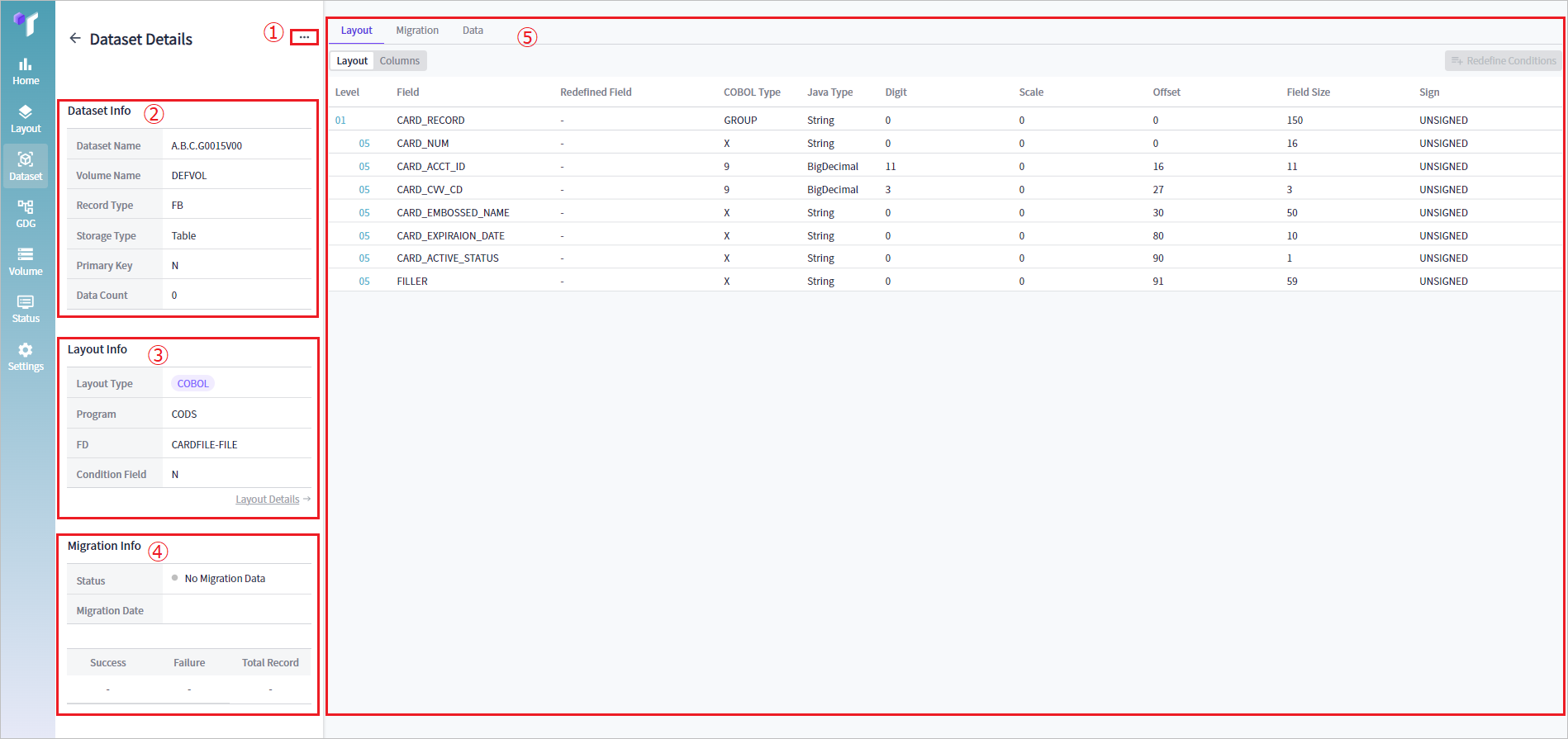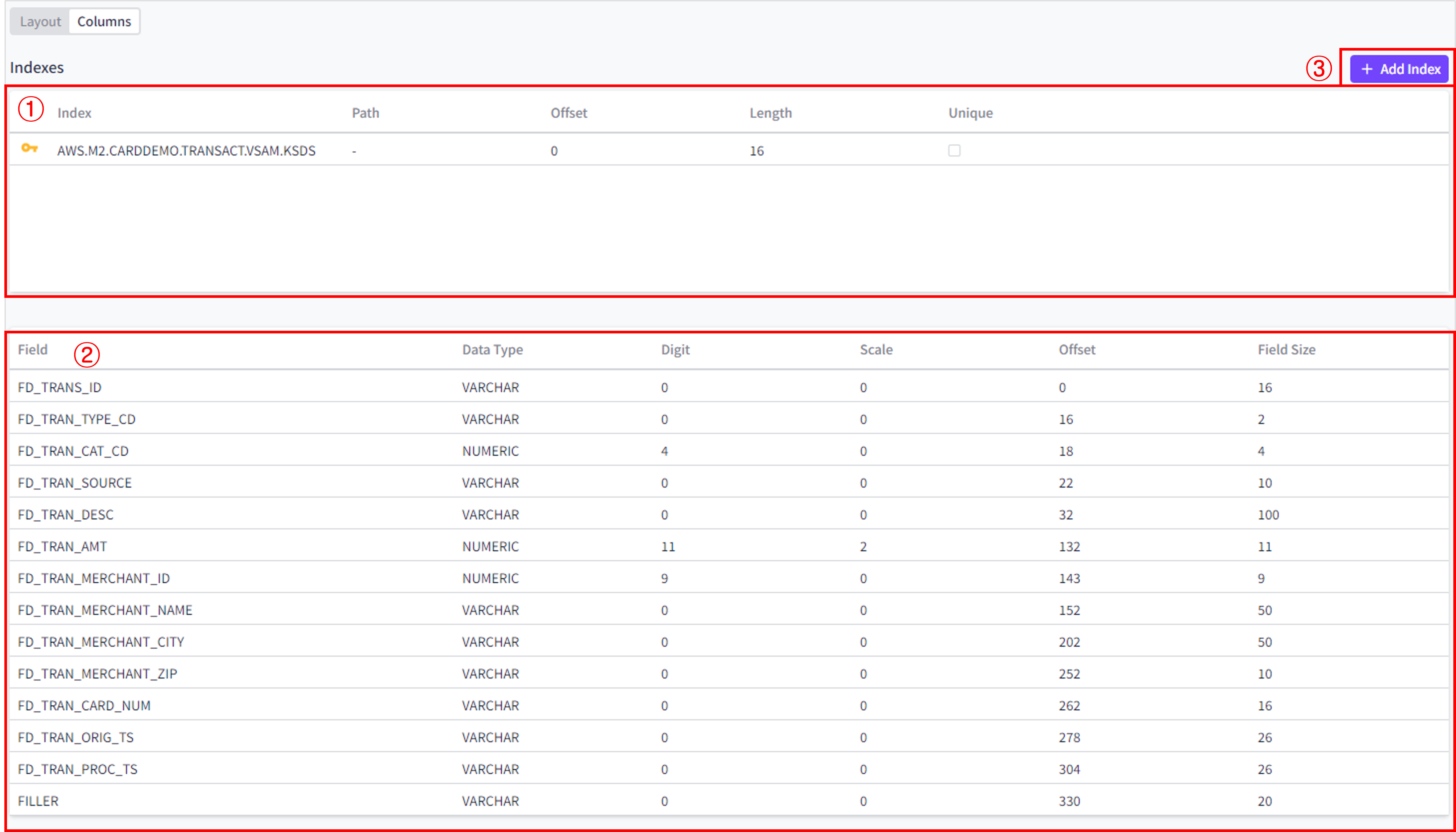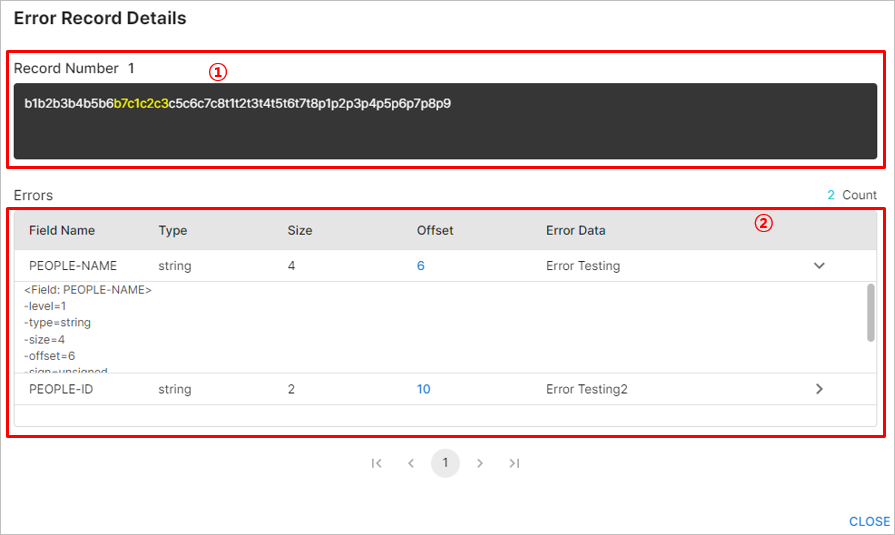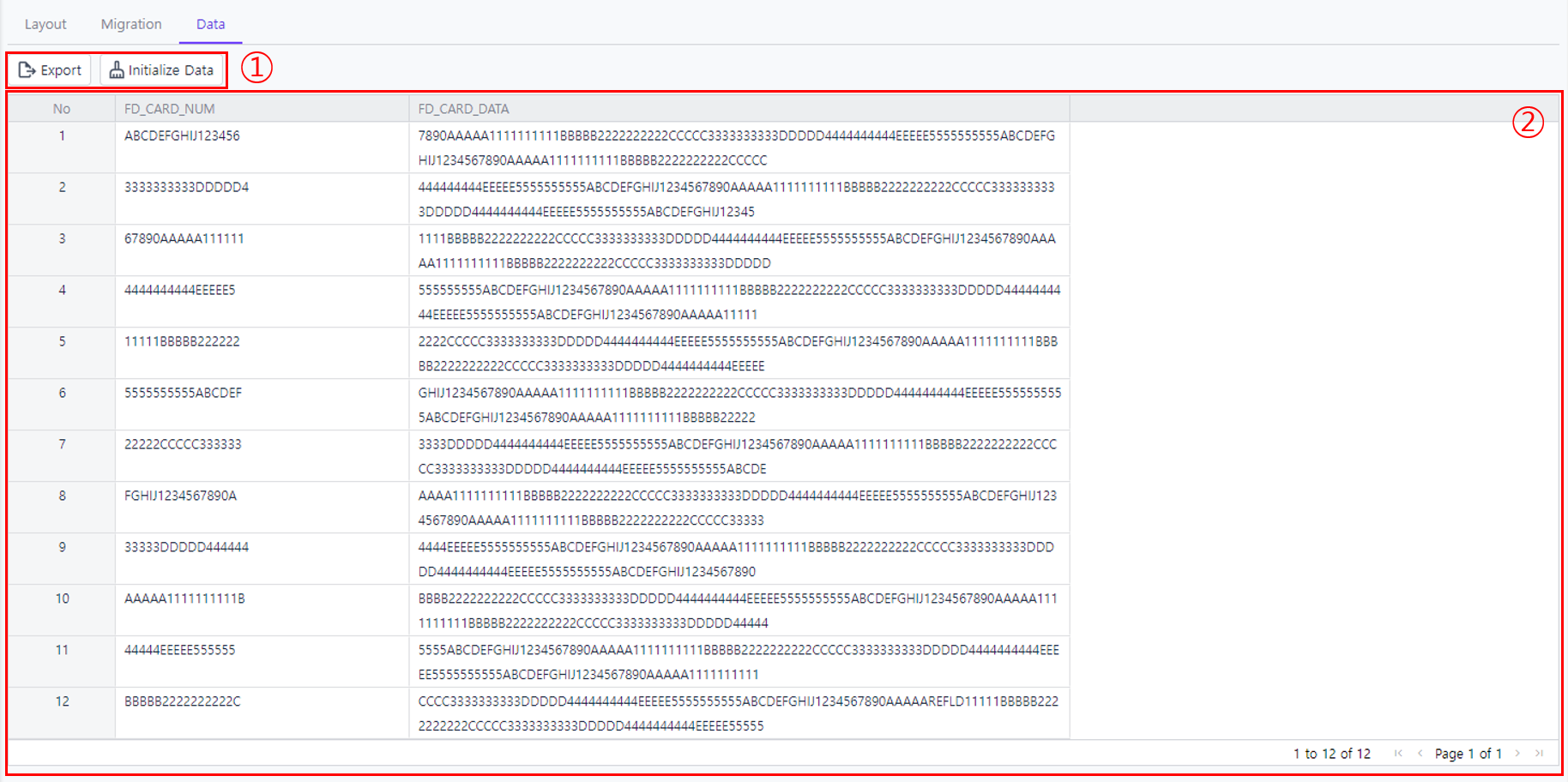Datasets Details
Dataset Details
If you click a dataset from the list in the Dataset screen, the Dataset Details page opens. The Dataset Details page provides detailed information about the dataset, and you can perform additional tasks for the dataset.

The Dataset Details page consists of the following.
-
① Function Buttons
f you click the [
 ] button on the Dataset Details page, a popover opens containing the [Generate Source] and [Delete] buttons. You can generate sources or delete the dataset by using these buttons.
] button on the Dataset Details page, a popover opens containing the [Generate Source] and [Delete] buttons. You can generate sources or delete the dataset by using these buttons. -
② Dataset Info
The Dataset Info view displays detailed information of the dataset.
The following describes each item.
Item Description Dataset Name
Name of the dataset.
Volume Name
Volume name of the dataset.
Record Type
Record type of the dataset.
-
FB: Fixed-length block
-
VB: Variable-length block
Storage Type
Storing type of the dataset.
-
File: Stores as file format
-
Table: Stores as table format
Primary Key
Presence of the primary key for the dataset.
-
Y: The primary key exists.
-
N: The primary key does not exist.
Data Count
Number of records in the dataset.
-
-
③ Layout Info
The Layout Info view displays detailed information about the layout referenced by the dataset.
The following descries each item.
Item Description Layout Type
Type of the layout referenced by the dataset.
Program
Program name of the layout referenced by the dataset.
FD
FD name of the layout referenced by the dataset.
Condition Field
Presence of a condition field of the layout referenced by the dataset.
-
Y: A condition field exists.
-
N: A condition field does not exist.
-
-
④ Migration Info
The Migration Info view displays detailed migration information.
The following describes each item.
Item Description Status
Indicates the migration status. If no migration is progressed, the 'No Migration Data' message is displayed.
The migration status is shown as one of the following:
-
Success: Migration has been successfully completed.
-
Failure: Migration has failed.
-
In Progress: Migration is in progress
-
Completed with Issue: Migration has been completed but additional checks are required.
-
No Migration Data: Migration has not been performed and no data is provided.
Migration Date
Date and time when the migration is completed.
Success
Number of successfully migrated records.
Failure
Number of records with errors after migration.
Total Record
Total number of records.
-
-
⑤Tabs
Consist of [Layout], [Migration], and [Data] tab.
[Layout] Tab
The [Layout] tab consists of the [Layout] section and the [Columns] section.
Layout Information
The [Layout] section displays a table of fields referenced by the dataset. If a redefined field exists, you can check the redefine information on the field.

-
① Layout Table
The layouts referenced during dataset creation are displayed in a tree table, which can be expanded or collapsed by level.
The following describes each item.
Item Description Level
Field level in COBOL.
Field
Field name.
Redefined Field
Base field name to redefine. If no data is available to redefine a field, "-" is marked.
COBOL Type
Field data type in COBOL.
Java Type
Field data type in Java.
Digit
Number of digits of the whole-number part in the field.
Scale
Number of digits of the decimal part in the field.
Offset
Starting point of the field indicated by the count of the bytes.
Field Size
Size of the field data in byte.
Sign
Indicates whether the number field in COBOL type contains a sign.
-
② [Redefine Conditions] Button
If you click [Redefine Conditions], you can redefine conditions for the dataset. This button is activated if the dataset includes redefined fields. If you click the button, the Redefine Conditions modal window opens. For more information, refer to Condition Redefinition.
Column Information
The [Columns] section displays a list of the fields created as table columns among the layout fields. You can also check the information of the primary key specified when creating a dataset, and create, delete, or search for an alternative index.

The [Columns] section consists of the following.
-
① Indexes Table
Displays a list of the primary keys and alternative indexes, with the primary keys marked by a key icon (
 ).
Clicking a primary key or alternative index will highlight the corresponding list of columns in the columns table.
).
Clicking a primary key or alternative index will highlight the corresponding list of columns in the columns table. -
② Columns Table
Displays a list of fields created as table columns among the layout fields.
-
③ [Add Index] Button
Creates a new alternative index. For more information, refer to Creating Alternative Indexes.
| The primary key name is created the same as the dataset name. |
[Migration] Tab
Displays the migration status, setting values and errors that have occurred during the migration process.
Migration Information
Provides overall migration information.

The following describes each item of information.
| Item | Description |
|---|---|
Status |
Migration status. |
Success |
Number of records that were successfully migrated. |
Failure |
Number of records failed to migrate. |
Total Record |
Total number of records. |
Migration Date |
Time and date of the migration operation. |
The following describes each setting value.
| Item | Description |
|---|---|
Delimiter |
Character that delimits source files. |
Storage Type |
Location to store migrated datasets. |
Skip Error |
Option to skip errors during migration. If set to Y, the migration operation continues despite errors. If set to N, migration stops upon encountering an error. |
Source File Path |
Directory where the target datasets to migrate are located. |
The following describes the functionality of the button.
| Button | Description |
|---|---|
[Migration] |
Executes migration. Clicking on this button opens a pop-up window in which you can specify the sources and options for migration. |
Migration Error Table
Lists errors that have occurred during migration.

The following describes each column.
| Column | Description |
|---|---|
Record Number |
Number of the record that encountered the error. |
Error Field Count |
Count of the fields where errors occurred. |
Exception Name |
Name of the error. |
Exception Message |
Error message. |
Clicking on a specific record in the error table allows you to access the Error Record Details page, which provides detailed information about the error.

The following describes each item of information and button available in the Error Record Details page.
-
① Record Number
Displays the number of the record that encountered the error along with the hexadecimal value of the record.
-
② Errors
Displays details of the error. Clicking on the extender icon [
 ] located at the right end of the table row shows the comprehensive details about the error.
] located at the right end of the table row shows the comprehensive details about the error.The following describes each column of information.
Column Description Field Name
Name of the field.
Type
Data type of the field in COBOL. There are 9 data types supported:
-
Group
-
String
-
National string
-
Integer (Big endian)
-
Float
-
Double
-
Integer
-
Packed decimal
-
Zoned decimal
Size
Size of the field data in bytes. (Starting from 0)
Offset
Starting position of the field in bytes. Clicking on the offset value in the table row highlights the corresponding offset area in the hexadecimal record value.
Error Data
Shows the message of the error.
-
[Data] Tab
The [Data] tab consists of function buttons and the migrated datasets list table.

-
① Function Buttons
The following describes each button.
Button Description [Export]
Exports migrated data into files. For more information, see Dataset Export.
[Initialize Data]
Initializes datasets, by clearing all records from them. For more information, see Initializing Datasets.
-
② Data Table
Provides a view of data from migrated datasets in a table. You can adjust the width of each column by dragging the column header. To extend the column width up to the length of the data, double-click the right end of the column header.
